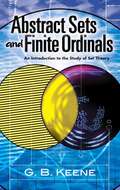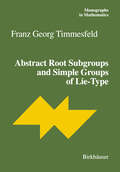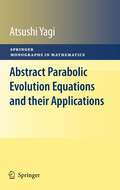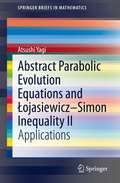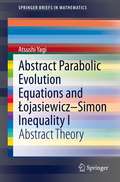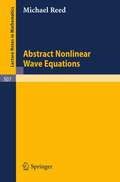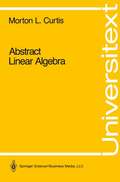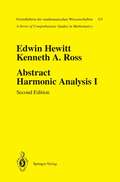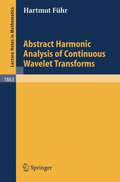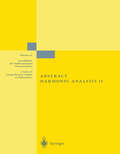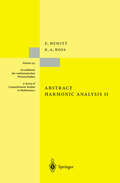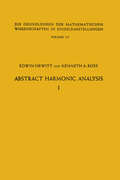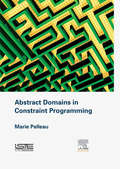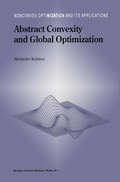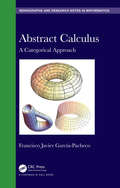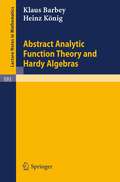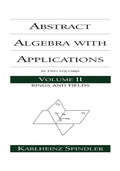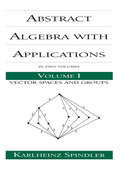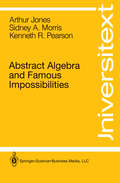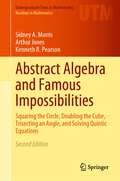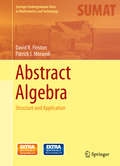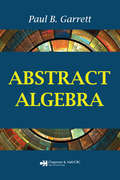- Table View
- List View
Abstract Sets and Finite Ordinals: An Introduction to the Study of Set Theory
by G. B. KeeneThis text unites the logical and philosophical aspects of set theory in a manner intelligible both to mathematicians without training in formal logic and to logicians without a mathematical background. It combines an elementary level of treatment with the highest possible degree of logical rigor and precision.Starting with an explanation of all the basic logical terms and related operations, the text progresses through a stage-by-stage elaboration that proves the fundamental theorems of finite sets. It focuses on the Bernays theory of finite classes and finite sets, exploring the system's basis and development, including Stage I and Stage II theorems, the theory of finite ordinals, and the theory of finite classes and finite sets. This volume represents an excellent text for undergraduates studying intermediate or advanced logic as well as a fine reference for professional mathematicians.
Abstract Root Subgroups and Simple Groups of Lie-Type (Monographs in Mathematics #95)
by Franz G. TimmesfeldThis book systematically treats the theory of groups generated by a conjugacy class of subgroups, satisfying certain generational properties on pairs of subgroups. For finite groups, this theory has been developed in the 1970s mainly by M. Aschbacher, B. Fischer and the author. It was extended to arbitrary groups in the 1990s by the author. The theory of abstract root subgroups is an important tool to study and classify simple classical and Lie-type groups.
Abstract Parabolic Evolution Equations and their Applications (Springer Monographs in Mathematics)
by Atsushi YagiThis monograph is intended to present the fundamentals of the theory of abstract parabolic evolution equations and to show how to apply to various nonlinear dif- sion equations and systems arising in science. The theory gives us a uni?ed and s- tematic treatment for concrete nonlinear diffusion models. Three main approaches are known to the abstract parabolic evolution equations, namely, the semigroup methods, the variational methods, and the methods of using operational equations. In order to keep the volume of the monograph in reasonable length, we will focus on the semigroup methods. For other two approaches, see the related references in Bibliography. The semigroup methods, which go back to the invention of the analytic se- groups in the middle of the last century, are characterized by precise formulas representing the solutions of the Cauchy problem for evolution equations. The ?tA analytic semigroup e generated by a linear operator ?A provides directly a fundamental solution to the Cauchy problem for an autonomous linear e- dU lution equation, +AU =F(t), 0
Abstract Parabolic Evolution Equations and Łojasiewicz–Simon Inequality II: Applications (SpringerBriefs in Mathematics)
by Atsushi YagiThis second volume continues the study on asymptotic convergence of global solutions of parabolic equations to stationary solutions by utilizing the theory of abstract parabolic evolution equations and the Łojasiewicz–Simon gradient inequality. In the first volume of the same title, after setting the abstract frameworks of arguments, a general convergence theorem was proved under the four structural assumptions of critical condition, Lyapunov function, angle condition, and gradient inequality. In this volume, with those abstract results reviewed briefly, their applications to concrete parabolic equations are described.Chapter 3 presents a discussion of semilinear parabolic equations of second order in general n-dimensional spaces, and Chapter 4 is devoted to treating epitaxial growth equations of fourth order, which incorporate general roughening functions. In Chapter 5 consideration is given to the Keller–Segel equations in one-, two-, and three-dimensional spaces. Some of these results had already been obtained and published by the author in collaboration with his colleagues. However, by means of the abstract theory described in the first volume, those results can be extended much more.Readers of this monograph should have a standard-level knowledge of functional analysis and of function spaces. Familiarity with functional analytic methods for partial differential equations is also assumed.
Abstract Parabolic Evolution Equations and Łojasiewicz–Simon Inequality I: Abstract Theory (SpringerBriefs in Mathematics)
by Atsushi YagiThe classical Łojasiewicz gradient inequality (1963) was extended by Simon (1983) to the infinite-dimensional setting, now called the Łojasiewicz–Simon gradient inequality. This book presents a unified method to show asymptotic convergence of solutions to a stationary solution for abstract parabolic evolution equations of the gradient form by utilizing this Łojasiewicz–Simon gradient inequality.In order to apply the abstract results to a wider class of concrete nonlinear parabolic equations, the usual Łojasiewicz–Simon inequality is extended, which is published here for the first time. In the second version, these abstract results are applied to reaction–diffusion equations with discontinuous coefficients, reaction–diffusion systems, and epitaxial growth equations. The results are also applied to the famous chemotaxis model, i.e., the Keller–Segel equations even for higher-dimensional ones.
Abstract Linear Algebra (Universitext)
by Morton L. CurtisIntended for a first course on the subject, this text begins from scratch and develops the standard topics of Linear Algebra. Its progresses simply towards its ultimate goal, the Theorem of Hurwitz, which argues that the only normed algebras over the real numbers are the real numbers, the complex numbers, the quaternions, and the octonions. The book stresses the complete logical development of the subject.
Abstract Harmonic Analysis: Volume I: Structure of Topological Groups Integration Theory Group Representations (Grundlehren der mathematischen Wissenschaften #115)
by Edwin Hewitt Kenneth A. RossAbstract Harmonic Analysis of Continuous Wavelet Transforms (Lecture Notes in Mathematics #1863)
by Hartmut FührThis volume contains a systematic discussion of wavelet-type inversion formulae based on group representations, and their close connection to the Plancherel formula for locally compact groups. The connection is demonstrated by the discussion of a toy example, and then employed for two purposes: Mathematically, it serves as a powerful tool, yielding existence results and criteria for inversion formulae which generalize many of the known results. Moreover, the connection provides the starting point for a – reasonably self-contained – exposition of Plancherel theory. Therefore, the volume can also be read as a problem-driven introduction to the Plancherel formula.
Abstract Harmonic Analysis: Volume II: Structure and Analysis for Compact Groups Analysis on Locally Compact Abelian Groups (Grundlehren der mathematischen Wissenschaften #152)
by Edwin Hewitt Kenneth A. RossThis book is a continuation of Volume I of the same title [Grund lehren der mathematischen Wissenschaften, Band 115 ]. We constantly 1 1. The textbook Real and cite definitions and results from Volume abstract analysis by E. HEWITT and K. R. STROMBERG [Berlin · Gottin gen ·Heidelberg: Springer-Verlag 1965], which appeared between the publication of the two volumes of this work, contains many standard facts from analysis. We use this book as a convenient reference for such facts, and denote it in the text by RAAA. Most readers will have only occasional need actually to read in RAAA. Our goal in this volume is to present the most important parts of harmonic analysis on compact groups and on locally compact Abelian groups. We deal with general locally compact groups only where they are the natural setting for what we are considering, or where one or another group provides a useful counterexample. Readers who are interested only in compact groups may read as follows: § 27, Appendix D, §§ 28-30 [omitting subheads (30.6)-(30.60)ifdesired], (31.22)-(31.25), §§ 32, 34-38, 44. Readers who are interested only in locally compact Abelian groups may read as follows: §§ 31-33, 39-42, selected Mis cellaneous Theorems and Examples in §§34-38. For all readers, § 43 is interesting but optional. Obviously we have not been able to cover all of harmonic analysis.
Abstract Harmonic Analysis: Structure and Analysis for Compact Groups Analysis on Locally Compact Abelian Groups (Grundlehren der mathematischen Wissenschaften #152)
by Edwin Hewitt Kenneth A. RossThis book is a continuation of vol. I (Grundlehren vol. 115, also available in softcover), and contains a detailed treatment of some important parts of harmonic analysis on compact and locally compact abelian groups. From the reviews: "This work aims at giving a monographic presentation of abstract harmonic analysis, far more complete and comprehensive than any book already existing on the subject...in connection with every problem treated the book offers a many-sided outlook and leads up to most modern developments. Carefull attention is also given to the history of the subject, and there is an extensive bibliography...the reviewer believes that for many years to come this will remain the classical presentation of abstract harmonic analysis." Publicationes Mathematicae
Abstract Harmonic Analysis: Volume I, Structure of Topological Groups Integration theory Group Representations (Die Grundlehren der mathematischen Wissenschaften)
by Edwin Hewitt Kenneth Allen RossAbstract Domains in Constraint Programming
by Marie PelleauConstraint Programming aims at solving hard combinatorial problems, with a computation time increasing in practice exponentially. The methods are today efficient enough to solve large industrial problems, in a generic framework. However, solvers are dedicated to a single variable type: integer or real. Solving mixed problems relies on ad hoc transformations. In another field, Abstract Interpretation offers tools to prove program properties, by studying an abstraction of their concrete semantics, that is, the set of possible values of the variables during an execution. Various representations for these abstractions have been proposed. They are called abstract domains. Abstract domains can mix any type of variables, and even represent relations between the variables. In this work, we define abstract domains for Constraint Programming, so as to build a generic solving method, dealing with both integer and real variables. We also study the octagons abstract domain, already defined in Abstract Interpretation. Guiding the search by the octagonal relations, we obtain good results on a continuous benchmark. We also define our solving method using Abstract Interpretation techniques, in order to include existing abstract domains. Our solver, AbSolute, is able to solve mixed problems and use relational domains.Exploits the over-approximation methods to integrate AI tools in the methods of CPExploits the relationships captured to solve continuous problems more effectivelyLearn from the developers of a solver capable of handling practically all abstract domains
Abstract Convexity and Global Optimization (Nonconvex Optimization and Its Applications #44)
by Alexander M. RubinovSpecial tools are required for examining and solving optimization problems. The main tools in the study of local optimization are classical calculus and its modern generalizions which form nonsmooth analysis. The gradient and various kinds of generalized derivatives allow us to ac complish a local approximation of a given function in a neighbourhood of a given point. This kind of approximation is very useful in the study of local extrema. However, local approximation alone cannot help to solve many problems of global optimization, so there is a clear need to develop special global tools for solving these problems. The simplest and most well-known area of global and simultaneously local optimization is convex programming. The fundamental tool in the study of convex optimization problems is the subgradient, which actu ally plays both a local and global role. First, a subgradient of a convex function f at a point x carries out a local approximation of f in a neigh bourhood of x. Second, the subgradient permits the construction of an affine function, which does not exceed f over the entire space and coincides with f at x. This affine function h is called a support func tion. Since f(y) ~ h(y) for ally, the second role is global. In contrast to a local approximation, the function h will be called a global affine support.
Abstract Calculus: A Categorical Approach (Chapman & Hall/CRC Monographs and Research Notes in Mathematics)
by Francisco Javier Garcia-PachecoAbstract Calculus: A Categorical Approach provides an abstract approach to calculus. It is intended for graduate students pursuing PhDs in pure mathematics but junior and senior researchers in basically any field of mathematics and theoretical physics will also be interested. Any calculus text for undergraduate students majoring in engineering, mathematics or physics deals with the classical concepts of limits, continuity, differentiability, optimization, integrability, summability, and approximation. This book covers the exact same topics, but from a categorical perspective, making the classification of topological modules as the main category involved. Features Suitable for PhD candidates and researchers Requires prerequisites in set theory, general topology, and abstract algebra, but is otherwise self-contained Dr. Francisco Javier García-Pacheco is a full professor and Director of the Departmental Section of Mathematics at the College of Engineering of the University of Cádiz, Spain.
Abstract Calculus: A Categorical Approach (Chapman & Hall/CRC Monographs and Research Notes in Mathematics)
by Francisco Javier Garcia-PachecoAbstract Calculus: A Categorical Approach provides an abstract approach to calculus. It is intended for graduate students pursuing PhDs in pure mathematics but junior and senior researchers in basically any field of mathematics and theoretical physics will also be interested. Any calculus text for undergraduate students majoring in engineering, mathematics or physics deals with the classical concepts of limits, continuity, differentiability, optimization, integrability, summability, and approximation. This book covers the exact same topics, but from a categorical perspective, making the classification of topological modules as the main category involved. Features Suitable for PhD candidates and researchers Requires prerequisites in set theory, general topology, and abstract algebra, but is otherwise self-contained Dr. Francisco Javier García-Pacheco is a full professor and Director of the Departmental Section of Mathematics at the College of Engineering of the University of Cádiz, Spain.
Abstract Analytic Function Theory and Hardy Algebras (Lecture Notes in Mathematics #593)
by K. Barbey H. KönigAbstract Algebra with Applications: Volume 2: Rings and Fields
by Karlheinz SpindlerA comprehensive presentation of abstract algebra and an in-depth treatment of the applications of algebraic techniques and the relationship of algebra to other disciplines, such as number theory, combinatorics, geometry, topology, differential equations, and Markov chains.
Abstract Algebra with Applications: Volume 1: Vector Spaces and Groups (Pure and Applied Mathematics)
by Karlheinz SpindlerA comprehensive presentation of abstract algebra and an in-depth treatment of the applications of algebraic techniques and the relationship of algebra to other disciplines, such as number theory, combinatorics, geometry, topology, differential equations, and Markov chains.
Abstract Algebra with Applications: Volume 2: Rings and Fields (Chapman And Hall/crc Pure And Applied Mathematics Ser.)
by Karlheinz SpindlerA comprehensive presentation of abstract algebra and an in-depth treatment of the applications of algebraic techniques and the relationship of algebra to other disciplines, such as number theory, combinatorics, geometry, topology, differential equations, and Markov chains.
Abstract Algebra with Applications: Volume 1: Vector Spaces and Groups (Chapman & Hall/CRC Pure and Applied Mathematics)
by Karlheinz SpindlerA comprehensive presentation of abstract algebra and an in-depth treatment of the applications of algebraic techniques and the relationship of algebra to other disciplines, such as number theory, combinatorics, geometry, topology, differential equations, and Markov chains.
Abstract Algebra and Famous Impossibilities (Universitext)
by Arthur Jones Sidney A. Morris Kenneth R. PearsonThe famous problems of squaring the circle, doubling the cube and trisecting an angle captured the imagination of both professional and amateur mathematicians for over two thousand years. Despite the enormous effort and ingenious attempts by these men and women, the problems would not yield to purely geometrical methods. It was only the development. of abstract algebra in the nineteenth century which enabled mathematicians to arrive at the surprising conclusion that these constructions are not possible. In this book we develop enough abstract algebra to prove that these constructions are impossible. Our approach introduces all the relevant concepts about fields in a way which is more concrete than usual and which avoids the use of quotient structures (and even of the Euclidean algorithm for finding the greatest common divisor of two polynomials). Having the geometrical questions as a specific goal provides motivation for the introduction of the algebraic concepts and we have found that students respond very favourably. We have used this text to teach second-year students at La Trobe University over a period of many years, each time refining the material in the light of student performance.
Abstract Algebra and Famous Impossibilities: Squaring the Circle, Doubling the Cube, Trisecting an Angle, and Solving Quintic Equations (Undergraduate Texts in Mathematics)
by Sidney A. Morris Arthur Jones Kenneth R. PearsonThis textbook develops the abstract algebra necessary to prove the impossibility of four famous mathematical feats: squaring the circle, trisecting the angle, doubling the cube, and solving quintic equations. All the relevant concepts about fields are introduced concretely, with the geometrical questions providing motivation for the algebraic concepts. By focusing on problems that are as easy to approach as they were fiendishly difficult to resolve, the authors provide a uniquely accessible introduction to the power of abstraction. Beginning with a brief account of the history of these fabled problems, the book goes on to present the theory of fields, polynomials, field extensions, and irreducible polynomials. Straightedge and compass constructions establish the standards for constructability, and offer a glimpse into why squaring, doubling, and trisecting appeared so tractable to professional and amateur mathematicians alike. However, the connection between geometry and algebra allows the reader to bypass two millennia of failed geometric attempts, arriving at the elegant algebraic conclusion that such constructions are impossible. From here, focus turns to a challenging problem within algebra itself: finding a general formula for solving a quintic polynomial. The proof of the impossibility of this task is presented using Abel’s original approach. Abstract Algebra and Famous Impossibilities illustrates the enormous power of algebraic abstraction by exploring several notable historical triumphs. This new edition adds the fourth impossibility: solving general quintic equations. Students and instructors alike will appreciate the illuminating examples, conversational commentary, and engaging exercises that accompany each section. A first course in linear algebra is assumed, along with a basic familiarity with integral calculus.
Abstract Algebra: Structure and Application (Springer Undergraduate Texts in Mathematics and Technology)
by David R. Finston Patrick J. MorandiThis text seeks to generate interest in abstract algebra by introducing each new structure and topic via a real-world application. The down-to-earth presentation is accessible to a readership with no prior knowledge of abstract algebra. Students are led to algebraic concepts and questions in a natural way through their everyday experiences. Applications include:Identification numbers and modular arithmetic(linear) error-correcting codes, including cyclic codesruler and compass constructionscryptographysymmetry of patterns in the real plane Abstract Algebra: Structure and Application is suitable as a text for a first course on abstract algebra whose main purpose is to generate interest in the subject or as a supplementary text for more advanced courses. The material paves the way to subsequent courses that further develop the theory of abstract algebra and will appeal to students of mathematics, mathematics education, computer science, and engineering interested in applications of algebraic concepts.
Abstract Algebra
by Paul B. GarrettDesigned for an advanced undergraduate- or graduate-level course, Abstract Algebra provides an example-oriented, less heavily symbolic approach to abstract algebra. The text emphasizes specifics such as basic number theory, polynomials, finite fields, as well as linear and multilinear algebra. This classroom-tested, how-to manual takes a more narra
